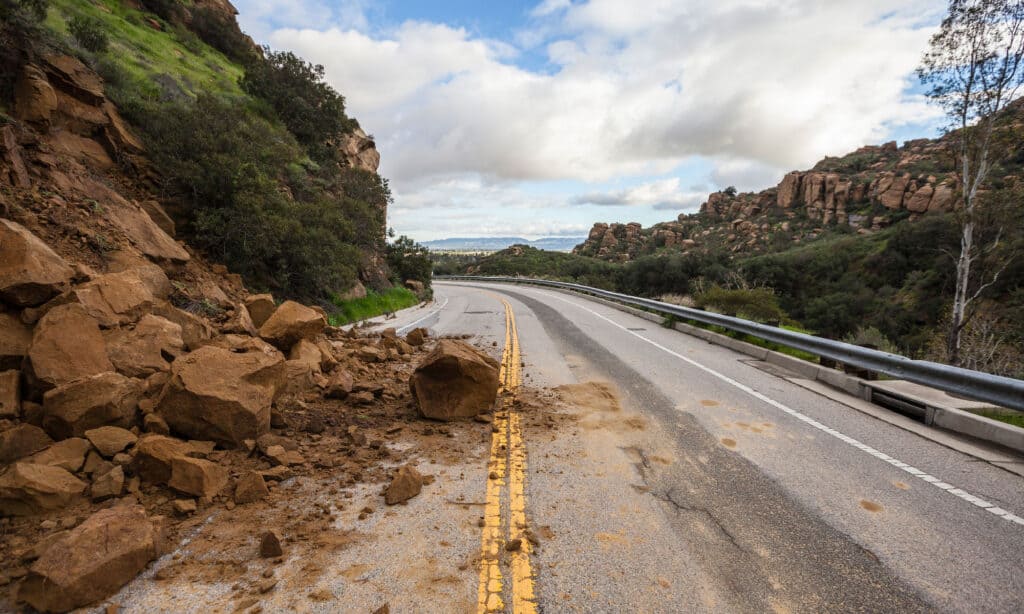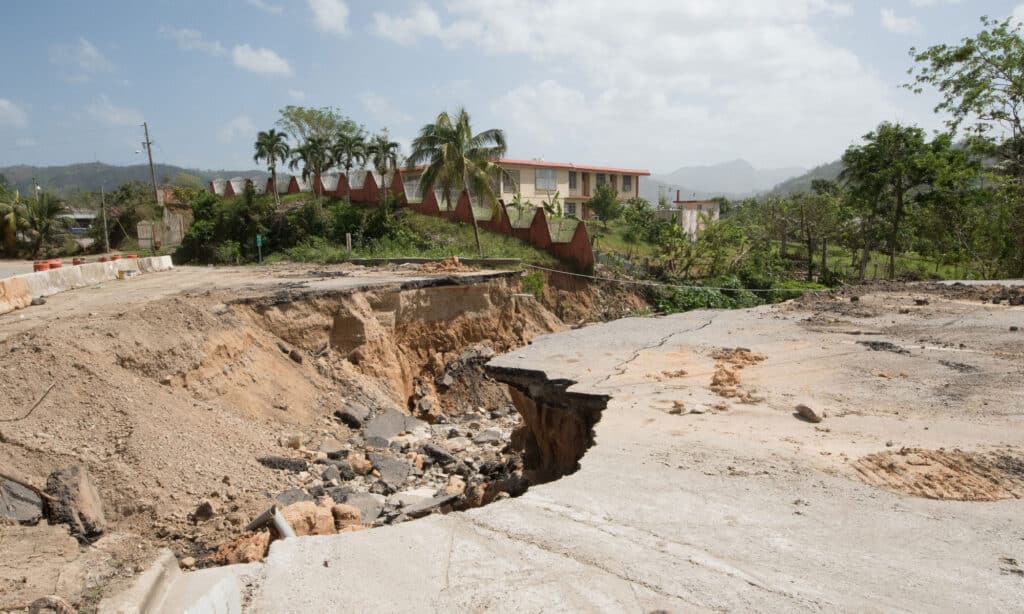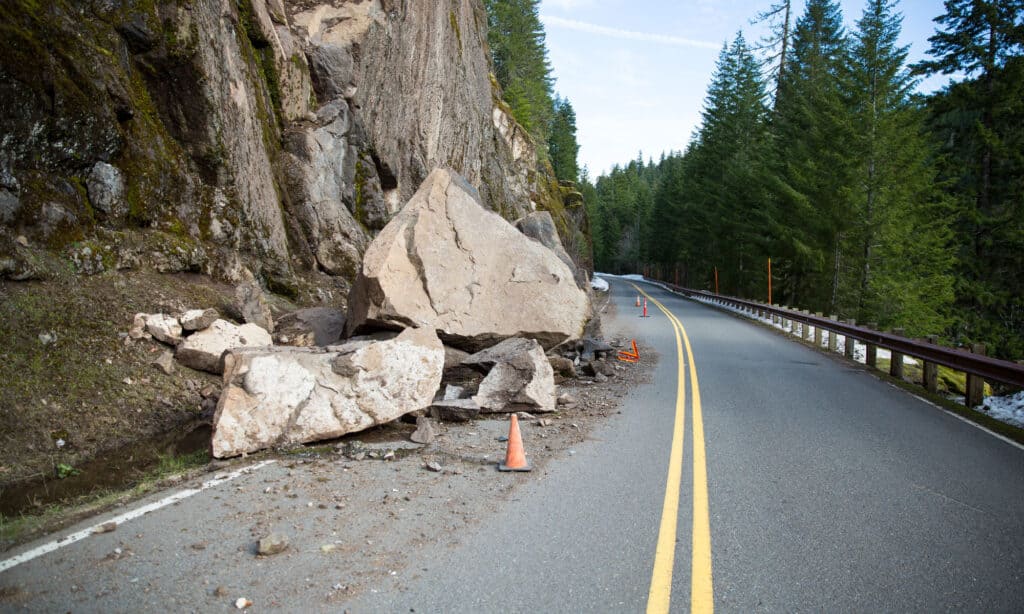Oregon is known for its cool and humid weather and its frequent rainfall. Unfortunately, rain does more than keep it lively and productive. Scientists have begun to emphasize the connection between rainfall and mudslides.
Truly, Oregon has experienced several landslides and mudslides ranging from small slides to massive mudflows and avalanches preceded by rains or earthquakes. Some have caused massive damage, while others only created inconveniences like road blockages.
Oregon has had over 12,000 slides, and scientists predict that others will follow in the coming years. This article will discuss the most devastating mudslides in Oregon and why the state experiences them so often.
The Most Devastating Mudslides in Oregon
Willamette Valley Flood (1996 mudslides)

There were over a hundred mudslides in Portland.
©Credit: National Weather Service Portland / Courtesy of U.S. Army Corps of Engineers / This work is in the public domain in the United States because it is a work prepared by an officer or employee of the United States Government as part of that person’s official duties under the terms of Title 17, Chapter 1, Section 105 of the US Code
One of the earliest mudslides recorded in Oregon happened after the great storm of 1995-1996. The storm caused massive flooding and damage to 18 counties in Oregon, including Douglas County. There were over a hundred mudslides in Portland.
Almost 22,000 people needed to be evacuated as they had lost their homes. About 8 people died, including a newspaper delivery man, Rick and Susan Moon, and Sharon Marvin, who was swept off in the mud. Over 700 cattle perished as almost 5 inches of rain fell along the Central Oregon Coast. The mudslides also shut down Interstate 5 at the time, creating traffic.
Oregon Highway 6 Mudslide
On the 26th of March 2014, a mudslide occurred at milepost 32 on Oregon Highway 6. The slide closed the highway on either side: Banks on the east side of the Coast and Tillamook on the West. Like many other mudslides, most of which are not reported, this mudslide only obstructed the road. No fatalities were recorded, and no private properties were lost. All that needed to be done was clear the road.
However, it is essential to note here that the mudflow has eroded several parts of land in the area. Like many other parts of Oregon, this means that the site is susceptible to a repeat mudslide. This time, it may not be as minor as the 2014 slide.
2021 Oregon Coast mudslide
In November 2021, the Coast Guard set out on a rescue mission when mudslides shut off roads and ambushed some campers on the Oregon Coast. An RV park southwest of Portland had become terribly flooded as RVs sat in 6 inches of water, while the depth in some areas had reached 4 feet. There had been flooding warnings before this period and announcements on the risk of mudslides.
This campground in Neskowin Creek was a couple of miles from Otis. Otis had previously been destroyed by a wildfire a year before. Thus, the odds of mudslides and landslides occurring and getting to the surrounding areas were high. And, the mudslide did come. Areas that have been ravaged by wildfires are at massive risk of being swept off in mudslides. It is best to abstain from such places or set active safety protocols in the event of unexpected rainfall and flooding.
Often, the speed of mudflows makes rescue attempts difficult, and more lives could be lost. Luckily, The Coast Guard saved about 50 people, including three dogs.
What Causes Mudslides?

Mudslides can be triggered by human disturbance of previous landslide sites, the constant felling of trees, and poor slope grading.
©iStock.com/trekandshoot
Human Activity
Mudslides can be triggered by human disturbance of previous landslide sites, the constant felling of trees, and poor slope grading. Suppose a landslide site has encountered too much rainfall or already had high water content, in that case, disturbance of the area could trigger a mudslide.
For instance, moving debris or rocks or branches could disrupt the stability and cause a water surge to flow and flood the area. Chopping down trees and changing landmarks without proper consideration for the soil and terrain could also start a mudslide.
Natural Forces
Earthquakes, wildfires, volcanic eruptions, quick snow melting on mountain tops, and changes in water levels are natural occurrences that could kickstart a mudslide. If heavy snow suddenly melts into water, it could cause soil and debris along a mountainside to flow rapidly. Depending on the quantity or snowmelt in question, and the site’s status, it could cause a mudslide.
Earthquakes can also shake up areas that ordinarily withstand winds or mild storms and create heavy flooding. Although these circumstances can hardly be prevented, monitoring active volcanoes, earthquakes, and rainfall in slide-prone areas are necessary preventive measures.
What Happens after Mudslides?

©iStock.com/cestes001
Natural disasters rarely leave towns or locations better or the same way they met them. And mudslides are no exception. Often, there are fatalities and damages to infrastructures, roads, homes, or public facilities. In worst-case scenarios, landslides make ghost towns of cities and communities. So, after the storm or flood has stopped, the first step is damage assessment.
Where people can easily pick up their lives and make minor repairs, cleanup begins. In other cases, governments have to start repairs and reconstruction to make such sites habitable again. Of course, the risk of recurrence will be put into high consideration during such periods. Some authorities take corrective measures or preventive measures where necessary. Or keep firm restrictions on areas with a history of slides.
Landslides in Oregon Today

Slide mapping is a good initiative to track mudslides since they are likely to reoccur in past locations.
©iStock.com/stewmangroup
The most recent landslide seems to have taken place in November 2021. Although there are no absolute measures for tracking landslides yet, the Oregon Department of Geology and Mineral Industries has mapped all landslide locations in Oregon. This compilation contains about 12,095 places where slides previously occurred across Oregon.
Slide mapping is a good initiative since we know that landslides are very likely to reoccur in past locations. This way, sites can be monitored, and timely warnings issued when floods or natural forces that could trigger debris flows occur. The best remedy is to stay alert and contact local authorities if any threat is perceived. Immediate evacuation is also very effective, as you never know how bad or how long landslides can last. It will also lower the risk of getting trapped or buried.
The photo featured at the top of this post is © iStock.com/Elmar Gubisch
Thank you for reading! Have some feedback for us? Contact the AZ Animals editorial team.






